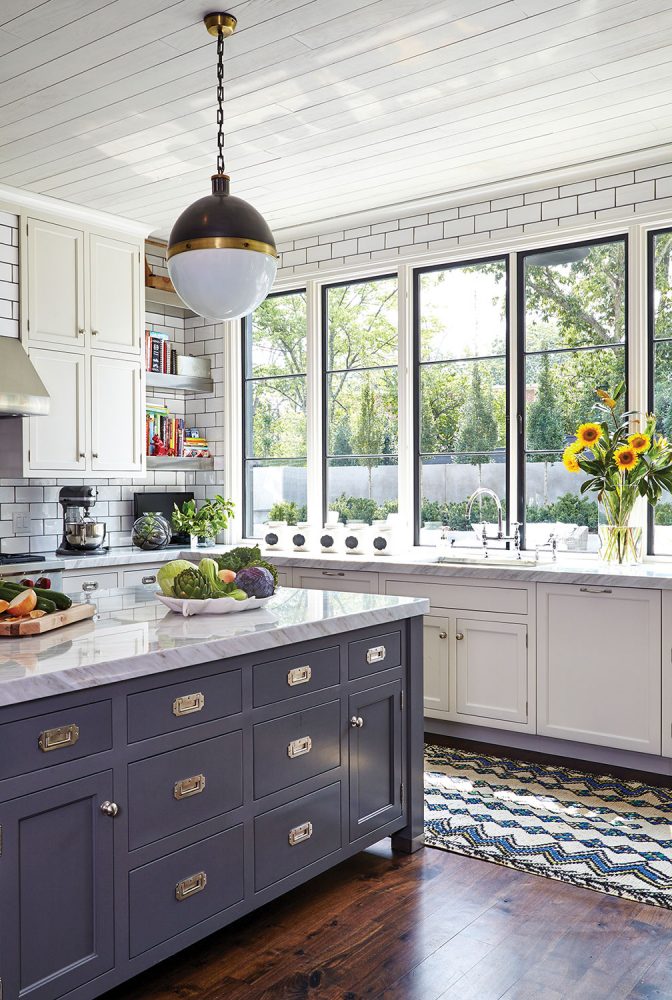Q&A
Flower: You grew up in a tiny Alabama town—your father was a farmer and your mother, a teacher. What exposure did you have to the design world?
Paige Sumblin Schnell: My mother subscribed to numerous shelter magazines. When she was done looking through them, she’d give them to me, and I’d read them cover to cover. I was fascinated by all the different colors and patterns, but I was absolutely obsessed with the floor plans that were offered in the back of every issue. I would trace them and add onto them or cut them out and move rooms around. I’d also comb through the pages and cut out photos of furniture, lamps, and other pieces that I loved.
So instead of making paper dolls, you made paper houses.
Exactly! My mother was a pioneer DIY-er and firmly believed in making things rather than buying them. When the Barbie Dream House came out, she encouraged me to make my own. I used my magazine floor plan like a blueprint and built it from a big Sears box. Inside, I painted some of the walls and lined others with wallpaper made from scraps of fabric from my grandmother’s sewing kit. And, of course, I filled the rooms with the furniture I had clipped from magazines or I made from matchboxes, toothpicks, and other odds and ends.

In a bedroom at Florida’s Watersound Beach, turquoise trim frames the sea and sky views while burnt-orange bedding and accents evoke the warmth of the blazing sun.
I guess no one was surprised when you decided to study interior architecture at Auburn. What was your first job out of college?
After graduating, I moved to Atlanta and worked in commercial design for several years. It was a like whole different world.
In what way? Living in a big city as opposed to your tiny hometown? Or working in commercial design as opposed to residential?
Both. Living in Atlanta was an eye-opening experience personally and professionally, but I was referring more to the difference between the commercial design I did then and the residential design I do now. As a commercial designer, I worked on office buildings and shopping com- plexes that were hundreds of thousands of square feet and dealt with codes and restrictions and much bigger budgets.

Sleek stone countertops, natural wood floors, and dimensional subway tile lend depth to a neutral Nashville kitchen.

An oversize antique clock anchors the living room of a Nashville home.
Why did you make the switch?
My husband and I were ready for a change of pace, so we decided to leave the hustle and bustle of the city and enjoy a more relaxed lifestyle at the beach in Seagrove, Florida. There wasn’t much of a need for commercial designers there, so I embarked on residential design and started my own firm, Tracery. Now I find myself sitting around a breakfast table with a couple and their kids versus a conference table with 20 lawyers.

Gilded accents, a tufted banquette, and cabinets with smoky mirrored panels create a luxe, boutique-inspired ambience in a master closet in Nashville.

Rough-hewn beams tone down the formality of a living room on Lake Martin in Alabama.
How would you define your style, and how do you inject it into your clients’ homes in a way that still makes each project distinctive?
My style marries vivid color and bold pattern with clean-lined furnishings and fuss-free finishes. I don’t force that on my clients. I just introduce them to those things they might not have considered. I obviously want them to be comfortable in their own homes, but I also want them to take risks and think outside the box.
The scope of your work is very diverse. Your book, Tracery: The Art of Southern Design, walks readers through 19 houses you designed across the South—many of which are second homes. Do you take a different approach when designing a getaway versus a primary residence?
Absolutely. At a vacation home, “house rules” don’t always apply. For instance, you might not think twice about sitting on the sofa in a wet bathing suit, but you’d NEVER do that back home. Design decisions must be practical. You need to consider how sunscreen can wreak havoc on fabrics and how sand can get stuck in a rug. You need to choose materials that will not only support but encourage the carefree mentality you want to have while you’re there.

Flowering vines grow across a wall of Gothic arches in an Alys Beach, Florida, courtyard.
How do you approach the design from an aesthetic perspective? Do you look to the location for inspiration?
I take cues from the surroundings but steer clear of anything kitschy. For example, you’re at a mountain lodge; you don’t need a sign on the door that says welcome to the mountains. Forgo acorn or grizzly bear motifs, and think of subtle ways to capture the spirit of the surroundings. An oversized armchair upholstered in plaid evokes the warmth of a flannel shirt you’d wear on a hike. A floor-to-ceiling stacked-stone fireplace echoes the majestic profile of the mountainside. A rich stain on wood floors or furnishings looks seamless against a backdrop of mature trees.
By Margaret Zainey Roux | Photography by Jean Allsopp




